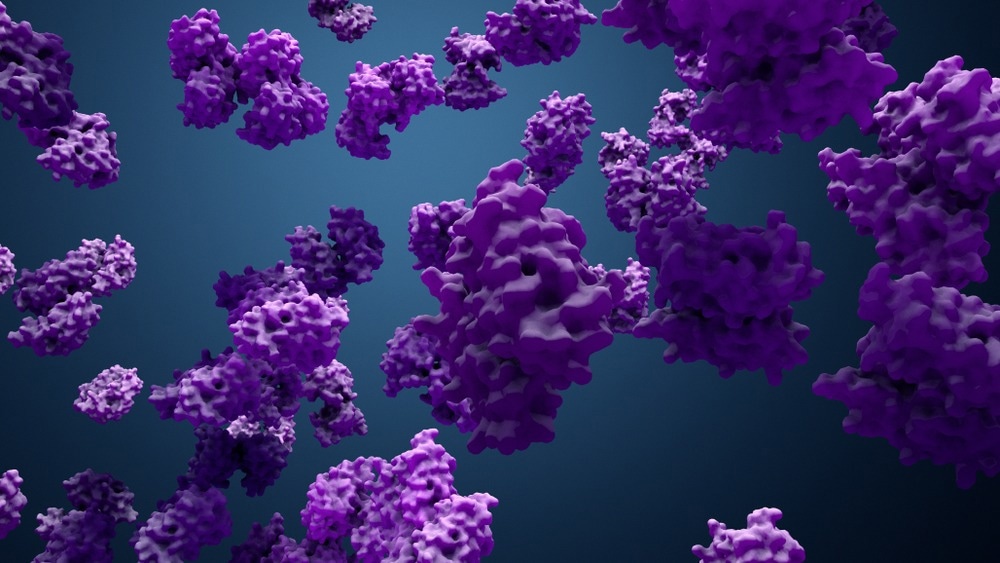On the basis of genetic blueprints, individual amino acids have been assembled into long amino acid chains, the proteins, in the protein factories of human cells, called the ribosomes.

Image Credit: Design_Cells/Shutterstock.com
Every newly developed protein starts with the amino acid methionine. Frequently, this amino acid is split off again at the time of protein synthesis, once the increasing amino acid chain exits the protein factory via the so-called “ribosomal tunnel”.
In such cases, the excision of methionine is necessary to guarantee the following function of the equivalent proteins present in the cell.
The enzymes leading to this cleavage are known already. As per their function, they are known as methionine aminopeptidases (METAPs). So far, it was yet to be understood how METAPs get into contact with the protein factories and, just at the correct place and moment, result in the excision of methionine from specific proteins.
Biologists Elke Deuerling, Martin Gamerdinger, and their group from the University of Konstanz (Germany), collaboratively with Nenad Ban and his partners from ETH Zurich (Switzerland), have currently gained more insights on the subject.
The outcomes reported in Science show: access of METAPs to protein factories is regulated by a “ribosomal gatekeeper” known as NAC (short for “nascent polypeptide-associated complex”).
More Extensive Function Than Previously Known
Only last year (2022), the team guided by Deuerling and Gamerdinger was able to clarify that NAC executes a significant sorting function at the ribosomal tunnel.
We were able to show that NAC sits in front of the tunnel exit like a gatekeeper. There it controls the transport of proteins to the endoplasmic reticulum (ER)–the membrane network inside the cell—by specifically bringing together protein and transport molecule (SRP).”
Elke Deuerling, Biologist, University of Konstanz
In their new study, the scientists show that the gatekeeper’s sorting function is highly extensive and even more considerable than earlier known and that NAC also guarantees the proper methionine excision from nascent proteins.
In proteins transported to the ER, the first amino acid methionine is considered part of a transport signal.
Methionine excision in these proteins would destroy the signal and thus prevent its transport into the cell’s membrane network, which would inevitably lead to cell death.”
Martin Gamerdinger, Biologist, University of Konstanz
The major scientific mystery was how these transport signals are prevented from being ruined by METAPs. However, the puzzle has been currently solved by the researchers from Konstanz and Zurich: The gatekeeper NAC develops a complicated METAP1 and the ribosome at the exit of the ribosomal tunnel. Just within this complex, the enzyme makes the excision of methionine from proteins that are newly formed.
This gets altered once a protein with a transport signal exits the ribosomal tunnel. Interactions between the protein’s signal sequence and NAC further make the gatekeeper alter its position at the ribosomal tunnel.
Consecutively, METAP1 discards it is binding to NAC and, thus, its potential to cleave off methionine. With the gatekeeper’s altered position, a new binding interface turns out to be highly accessible for the transport molecule SRP.
This mechanism means that proteins lacking signal sequences can be specifically modified by methionine excision. Those, in contrast, that are transported to the endoplasmic reticulum, remain unaffected by METAP1.”
Martin Gamerdinger, Biologist, University of Konstanz
The Gatekeeper as a Mediation All-Rounder?
The researchers hypothesize that NAC may have other similar mediating functions at the ribosomal tunnel, thus assuming the role of a general molecular control center.
Deuerling concludes, “There is a large number of enzymes and transport molecules that, like METAP1 and SRP, interact with the nascent proteins already during protein synthesis. Future studies will therefore have to show whether NAC also plays a role in regulating other processes that are vital for the function of our cells.”
Source:
Journal reference:
Gamerdinger, M., et al. (2023) NAC controls cotranslational N-terminal methionine excision in eukaryotes. Science. doi.org/10.1126/science.adg3297